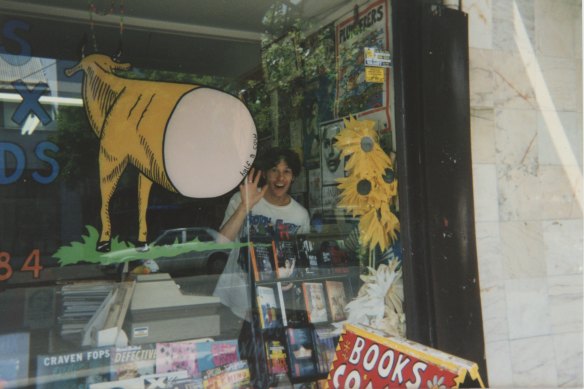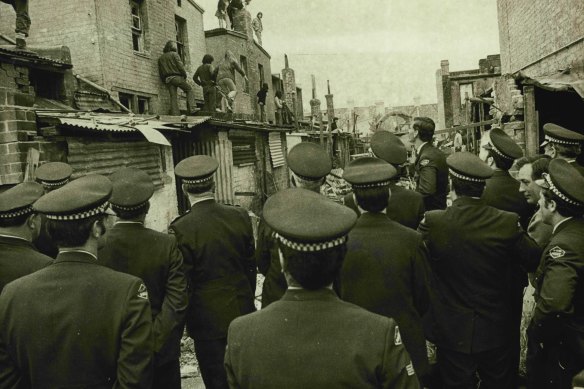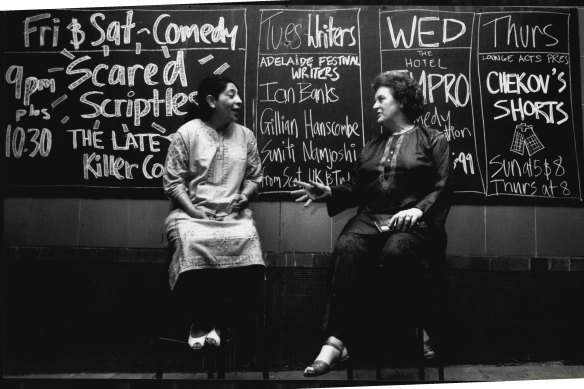This was published 11 months ago
Glebe is the pop culture mecca of Sydney. Here’s why
In our new Sydney Scenes series, we ask writers to make the case for why their suburb is the best when it comes to pop culture. Up next, Glebe.
Glebe goes a little under the radar. It’s not quite Newtown, and a world away from Surry Hills. Its working-class history is outdone by Balmain’s, and if you had to draw a picture that encapsulates Glebe, you might not know where to start.
But look a little closer, and you’ll find it is steeped in the city’s history as a place of protest, a cauldron of counterculture, and a microcosm of debate over Sydney’s look, feel and character.

Nic Dalton inside the legendary Half A Cow on Glebe Point Road in 1991.
It was on Glebe Point Road that celebrated architect Edmund Thomas Blacket built Bidura in 1858, a two-storey villa in the colonial regency style. Lately, the heritage-protected building and adjacent former children’s court have sat neglected, attracting vandals and trespassers, while awaiting a residential redevelopment.
The site and its future have been core business for the Glebe Society, one of Sydney’s more storied residents’ groups, perhaps best known for its role in the green bans of the 1970s. It held its first meeting at Glebe Town Hall on June 19, 1969, and two years later helped elect to Leichhardt Council a conservationist coalition led by Trotskyist mayor, Nick Origlass.
Of the many battles the society has been involved in since, the greatest was against the planned western and north-western expressways, which were to tear through Ultimo and Glebe.
It came to a head in 1974’s so-called “Fig Street confrontation” in adjacent Ultimo, when 12 were reportedly arrested protesting the Department of Main Roads’ demolition of homes. Plans for the two offending freeways were permanently dumped after the election of Neville Wran.

Demonstrators take to the rooftops in their attempt to stop demolition on the Western Expressway site on September 30, 1974.Credit: Russell McPhedran/Fairfax Media
In the same year as the battle of Fig Street, Anne Summers and her women’s lib comrades started squatting in two vacant church-owned houses, Elsie and Minnie, changing the locks and creating the Elsie Women’s Refuge Night Shelter, the first of its kind in Australia.
A stone’s throw from Sydney University and later a short walk from the University of Technology, Glebe has long been a backyard of sorts for students and academics. In the 1960s you might have found members of the Sydney Push there; Germaine Greer and Roelof Smilde shared an apartment on the main drag for a period, and Smilde became a lifelong local legend.
Upon his death in 2017, the Glebe Society noted he was “a regular visitor to Sonoma Cafe and AB Hotel in later years … always seen consuming The Sydney Morning Herald, completing the cryptic crossword and sudoku”.
In the 1980s, students hung out at the legendary Badde Manors cafe, an institution that “changed the city forever”. In the ’90s, they might have frequented Half A Cow, Nic Dalton’s bookshop-cum-record store on Glebe Point Road, and birthplace of the eponymous record label.

Writers Suniti Namjoshi and Gillian Hanscombe at the Harold Park Hotel in March 1992.Credit: Elizabeth Dobbie/Fairfax Media
As journalist Barry Divola recently reminisced, the shop was a mecca for like-minded creatives at a time when Glebe “still had cheap rent, cheap restaurants and cafes where you could sit all day over a few cups of coffee, reading a book or trying to write the great Australian novel”.
Of course, Glebe’s cultural contributions are not just literary, musical and academic. For 120 years, until 2010, Harold Park Paceway was the city’s home of harness racing, with a world record crowd of 50,341 attending the 1961 Inter Dominion final.
Across the road, the Harold Park Hotel was an incubator of Australian talent of all kinds. It hosted up-and-coming rock bands, stand-up comics, writers’ forums and political panels. Local funnyman Akmal Saleh called it “the best venue ever”, and the late, legendary Robin Williams even popped in for at least one impromptu set. In 1986, dozens of police officers stormed the Harold Park stage to arrest communist writer Frank Hardy over thousands of dollars worth of unpaid traffic fines. Like many Sydney venues, the pub has also been a victim of noise complaints from NIMBY neighbours.
On the CBD side of the suburb, the Wentworth Park greyhound track is still a temple to working-class leisure, though a big question mark hovers over its future. Anachronistic though the track may now seem, one of Sydney’s great chroniclers, Perry Keyes, sees it as a sanctuary on his 2020 track Wentworth Park.
Keyes’ friend Tim Freedman, frontman of the Whitlams, saw a girl sitting alone outside a house party in Glebe; she became the muse for Beauty in Me, from the 2006 album Little Cloud. “Cross-legged on the front lawn, she’s had a bad pill / Lights of the city, they can all go to hell.”
Not far from there is the former Astor Theatre, later the Valhalla. In his authoritative history of Glebe, Grandeur and Grit, historian Max Solling writes: “It wasn’t a Saturday afternoon for Glebe children if they didn’t go to the movies at the Astor.” It’s now a Pilates studio and cooking cafe.
And on the corner of Broadway and Mountain Street you’d find the remains of the old Phoenician Club, where Nirvana played their first Australian gig in 1991.
The Glebe of 2024 can feel a bit like a graveyard, haunted by the husks of these grand, dormant institutions. Badde Manors, once a beloved late-night coffee house, shuts at 3pm these days. Glebe Point Road generally struggles after dark. House prices are so high there is little hope for the young renter or the first home buyer.
Still, there is joy here. The Glebe markets are a gem and a Gen Z-magnet; Saturdays have never felt busier. Literature and music live on at Sappho, Gleebooks has just been renovated, and George the cockatoo still squawks at the Friend in Hand. Some things change, some stay the same.
What do you think the best suburb in Sydney is for pop culture? Share your thoughts in the comments section.